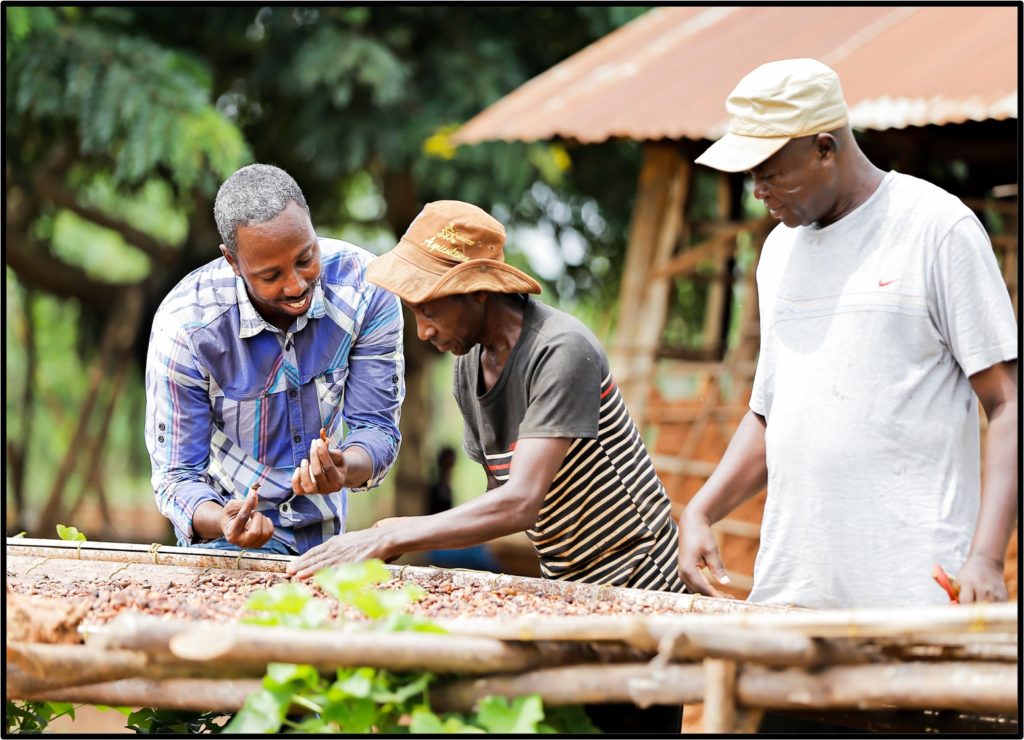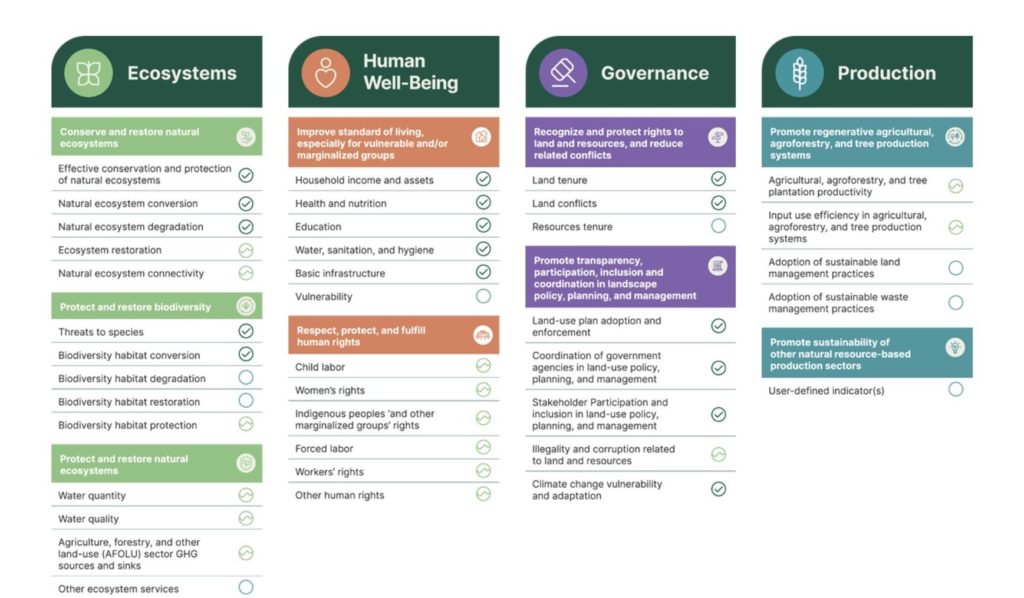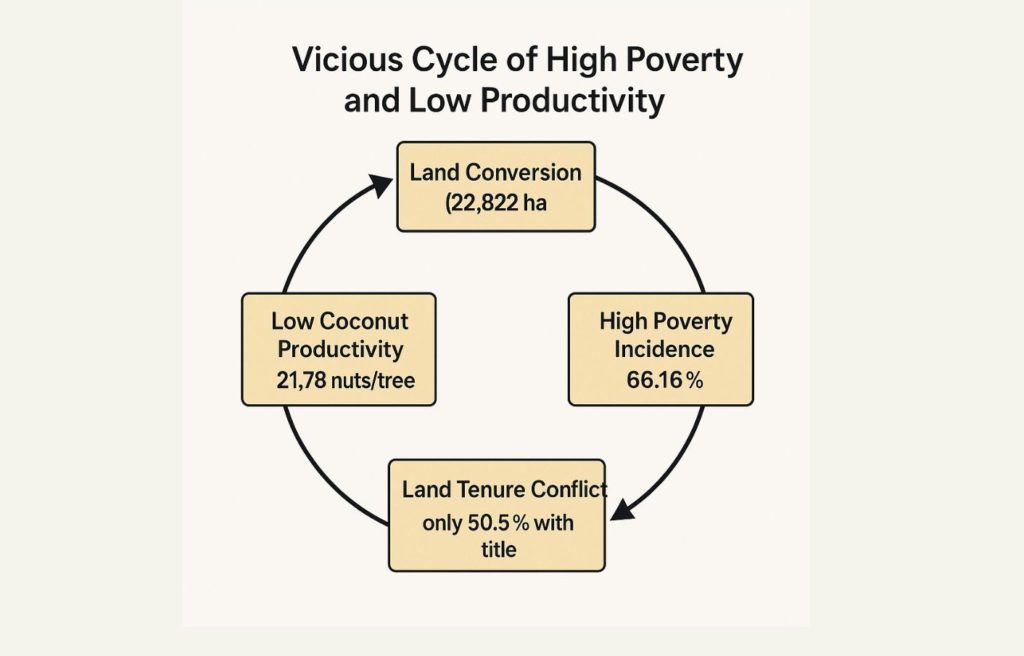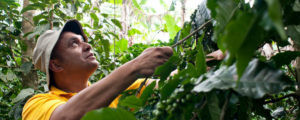Case study
Linking ecosystems, people, and production: An integrated approach to landscape sustainability
Our environmental, social, and economic systems are inextricably linked, and interventions that address one domain in isolation risk inefficacy and unintended consequences. Genuine, lasting change demands a comprehensive understanding of how systems function and interact. With this as its starting principle, LandScale’s assessment framework embodies a vital shift in how we understand and implement sustainability at the landscape level. Our framework takes a holistic approach, integrating four pillars - ecosystems, governance, human well-being, and production - to reflect the profound complexity of real-world landscapes. In this article, we will use the example of an initiative in the Philippines to explore the significance of each of the pillars, why their interconnection matters, and how an integrated assessment empowers organizations to drive meaningful, lasting impact.

Introduction
“In nature, nothing exists in isolation”. This insight from conservationist Rachel Carson captures a fundamental principle of sustainability. Ecosystems, economies, and societies are deeply interconnected, influencing one another in both visible and subtle ways. Any approach to sustainability that aims to drive effective, long-lasting solutions must begin by recognizing these interdependencies.
Our world is changing at an unprecedented pace. The rapid growth of globalization — both in markets and culture — has expanded and deepened our interconnectedness in ways previously unimaginable. This extends well beyond the tangible digital connections enabled by the internet; it also encompasses complex environmental and economic linkages. Decisions made in one region can have cascading effects across the world, whether through supply chains, climate impacts, or shifts in governance. While this interconnectedness brings opportunities, it also intensifies risks, making holistic, systems-based solutions more critical than ever.
Traditional approaches that focus solely on individual aspects, such as measuring carbon emissions or land degradation, often fail to capture the full picture. For instance, agricultural practices may affect biodiversity, while governance decisions can either support or undermine sustainable land use. Acknowledging this, integrated landscape assessments seek to forge a comprehensive framework that brings out and evaluates the links between natural systems, human well-being, and economic activities. By considering all these factors together, such assessments help to identify synergies, uncover hidden risks, and create solutions that are more effective, and more resilient to future challenges, particularly those exacerbated by climate change and global market instability.
These overlapping influences are well demonstrated by the Southern Leyte region of the Philippines – a region rich in biodiversity and agricultural productivity, but also marked by widespread deforestation, insecure land tenure, and economic precarity. Additionally, the area is increasingly vulnerable to climate change, with rising risks of typhoons, landslides, and coastal erosion further exacerbating environmental and economic instability. These are not merely parallel problems; they are tightly linked in feedback loops that amplify risks and erode resilience. This region clearly shows that a holistic framework is needed in order to address the plethora of interlocking challenges.
Introducing the LandScale framework
Our assessment framework is founded upon this nuanced, systems-based understanding. It evaluates landscape initiatives through four key pillars – ecosystems, governance, human well-being, and production – providing a multidimensional picture of a landscape’s condition. By weaving together these elements, the framework helps identify interventions that enhance productivity while safeguarding natural systems and communities. Grounded in rigorous data collection and stakeholder consultation, it can guide organizations and governance bodies to align with key environmental, social and governance goals (ESGs), including the United Nations Sustainable Development Goals (SDGs).
The core strength of LandScale lies in its ability to map interdependencies, ensuring that sustainability efforts are not only effective but enduring. Without this holistic perspective, initiatives risk being fragmented – or even counterproductive. By enabling stakeholders to recognize and act upon these interdependencies, LandScale provides an invaluable tool for designing and implementing high-impact sustainability strategies. To illustrate this, we will use the Southern Leyte region as our guide to how each of the four pillars is intertwined with the others.

Ecosystems: A key component of sustainability
Ecosystems play a foundational role in shaping sustainable landscapes, alongside governance, human well-being, and production. This pillar assesses key environmental indicators, including biodiversity, water and soil quality, and land use changes. While no single assessment can capture the full complexity of an ecosystem, selected indicators provide a meaningful picture of environmental health and its interactions with other dimensions of sustainability.
Pressures such as changes in land use, resource overexploitation, and climate change can destabilize landscapes in ways that extend far beyond ecological concerns. When ecosystems are degraded, production becomes less reliable, human well-being is affected, and governance challenges often emerge in response. Sustainability efforts must recognize and address these interdependencies in order to be effective.
For example, in the Southern Leyte region, deforestation driven by farmland expansion has led to declining soil quality and reduced water retention. These environmental shifts make it harder for local farmers to sustain their agricultural productivity, thus impacting incomes and living standards. This, in turn, can drive further farmland expansion, creating a reinforcing cycle of environmental and economic strain.
Governance: Enabling effective decision-making and implementation
The governance pillar examines the structures and processes that guide decision-making, including land tenure security and environment policy coordination. It focuses on assessing the integrity, effectiveness, and inclusivity of institutions in a landscape, and how they shape sustainability efforts. Effective governance can drive positive change by fostering transparency, reducing corruption, and building resilience against challenges such as climate change and market instability.
In commodity-producing regions, governance plays a particularly critical role. The ability to manage land and resources effectively is crucial to long-term sustainability. Equally important is the coordination between different governance bodies and the inclusion of vulnerable and marginalized groups, ensuring that decisions benefit all stakeholders in the landscape.
Research has shown that governance quality is often correlated with environmental performance. In high-income nations, strengthening governance structures typically improves environmental performance without requiring substantial changes to environmental policies. However, in middle- and low-income countries, the opposite trend is observed: improved governance alone may not suffice to improve environmental outcomes. For these countries, prioritizing environmental objectives over economic growth and enacting structural governance reforms are essential to achieving better environmental results. This underscores that governance is not only about institutional strength but about directing resources and priorities toward sustainable, long-term outcomes.
For instance, in Southern Leyte, many coconut farmers lack formal land ownership rights, which discourages long-term investment in sustainable agricultural practices. This lack of security also contributes to mismanagement of resources and unregulated land conversion. The LandScale assessment highlighted that improving land tenure and fostering more inclusive decision-making could help build long-term resilience, benefiting both livelihoods and local biodiversity.
Human well-being: Health, happiness, and prosperity
Sustainability is not just about ecosystems and governance; it is fundamentally about the people who inhabit and care for the land. The well-being of the population must be considered alongside the environment, as human actions are central to the health of the landscape. This pillar explores a range of factors, including economic security, access to resources, and the protection of human rights, all of which are essential to a thriving landscape.
In Southern Leyte, the link between ecosystem health and human well-being is starkly evident. Poverty rates exceed 66% in some areas and rise above 80% in others, with many households unable to meet even basic nutritional needs. Economic instability leads farmers to adopt unsustainable practices to meet immediate needs, further diminishing agricultural productivity and trapping communities in a cycle of poverty and environmental degradation.

Production: Promoting regenerative production systems
The production pillar is vital to sustaining livelihoods within a landscape, particularly in relation to agriculture and resource extraction. The pillar focuses on promoting regenerative agricultural practices, sustainable resource management, and, where relevant, responsible tourism. The goal is to support economic activity while ensuring that production methods minimize harm to the environment.
In Southern Leyte, farmers face significant challenges due to inadequate infrastructure and reliance on outdated farming techniques. Furthermore, the lack of formal land tenure limits farmers’ access to capital and disincentivizes investment in land improvements. Without secure ownership or the ability to leverage land for financial support, it is difficult for farmers to make long-term improvements to their operations.
Another major issue is the inequality within, for example, the coconut supply chain. Many smallholder farmers in the region are forced to sell raw coconut products at lower prices, rather than processing them into higher-value goods. Without access to appropriate processing facilities, these farmers miss the opportunity to increase their income and use the revenue to reduce the impact of their production practices. By addressing these gaps – through infrastructure improvements and support for value-added production – farmers could both raise their profits and transition to more sustainable agricultural practices, benefiting both their livelihoods and the surrounding environment.

Interconnectedness and the importance of integrated assessments
A truly holistic sustainability assessment must account for the intricate synergies and trade-offs that shape a region. Focusing narrowly on a single aspect – whether agricultural output, income levels, or environmental factors – can obscure deeper systemic interdependencies. As a study from 2021 highlights, “well-being frameworks that do not consider the environment (as constituent or determinant), or interrelationships between people and their environment, are not truly measuring well-being in all its dimensions”.
Our framework mitigates such gaps by helping uncover the causal relationships between different factors, offering a more complete understanding of sustainability challenges. While each pillar – ecosystems, governance, human well-being, and production – provides valuable insights on its own, it is through their interaction that a truly actionable and comprehensive perspective emerges. By facilitating a structured and iterative assessment process, LandScale allows for continuous refinement of sustainability strategies over time, while also providing organizations with clear benchmarks and performance indicators to track progress.
The Southern Leyte assessment we have discussed illustrates the value of this multi-layered approach. In this region, land tenure insecurity prevents farmers from making long-term investments in their productivity, exacerbating cycles of poverty and ecosystem degradation. Without a nuanced understanding of these interconnected issues, they might remain unaddressed, perpetuating their negative effects.
No pillar stands alone – each one interacts with the others in a dynamic, interconnected relationship. This principle is central to LandScale’s framework, underscoring how actions, whether positive or negative, reverberate through the entire system.
Conclusion: Moving towards a sustainable future
As we have explored, sustainability is far from a zero-sum game between society and the natural world; it is an intimately interwoven relationship, where the strengthening or weakening of one node invariably affects the others. This is why integrated sustainability assessments are critical. By examining the full range of interactions present in a system, they provide a structured framework for understanding both the root causes of sustainability challenges and the most effective pathways for change. Such assessments enable stakeholders to make more informed, data-driven decisions, ensuring that sustainability efforts are not just reactive but strategic and forward-looking.
LandScale’s rigorous assessments empower organizations – whether companies, governance bodies, or local stakeholders – to identify risks, uncover connections, and implement actionable strategies. In essence, our framework helps turn sustainability goals into measurable, impactful actions.
We believe that with thoughtful analysis and deliberate interventions, humanity and nature can thrive together. Our mission is to make that vision a reality.
Browse our Landscape Explorer to discover other landscapes that have already undergone LandScale assessments and uncovered interconnected insights.
Learn more about the assessment framework here, and access the Southern Leyte report here.